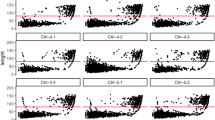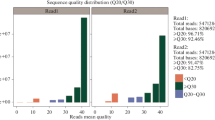Abstract
Mitochondrial DNA (mtDNA) heteroplasmy is a potential genetic marker for forensic mtDNA analysis as well as phylogenic studies. Frequency of mtDNA heteroplasmy has been investigated in different populations through massively parallel sequencing (MPS) analysis, revealing various levels of frequency based on different MPS systems. For accurate heteroplasmy identification, it is essential to explore reliable detection threshold on various MPS systems. In addition, software solutions and pipelines need to be evaluated to analyze data effectively. In this study, heteroplasmy analysis was conducted on a commercially available mtDNA analysis system developed for forensic caseworks with artificially mixed DNA samples known for ratios and variant positions for assessment. mtDNA heteroplasmy > 10% was detectable with Torrent Variant Caller (TVC) while lower levels were identified using GeneMarker® HTS specialized software for minor variant detection. This study implies that analytical parameters and tools need to be optimized and evaluated for low-level heteroplasmy identification. Automated system with simple and efficient workflow is needed for forensic caseworks.



Similar content being viewed by others
References
Birky CW (1995) Uniparental inheritance of mitochondrial and chloroplast genes: mechanisms and evolution. Proc Natl Acad Sci U S A 92(25):11331–11338. https://doi.org/10.1073/pnas.92.25.11331
Holland MM, Parsons TJ (1999) Mitochondrial DNA sequence analysis—validation and use for forensic casework. Forensic Sci Rev 11(1):21–50
Cavalli-Sforza LL, Feldman MW (2003) The application of molecular genetic approaches to the study of human evolution. Nat Genet 33(Suppl):266–275. https://doi.org/10.1038/ng1113
Budowle B, Allard MW, Wilson MR, Chakraborty R (2003) Forensics and mitochondrial DNA: applications, debates, and foundations. Annu Rev Genomics Hum Genet 4(1):119–141. https://doi.org/10.1146/annurev.genom.4.070802.110352
Parson W, Gusmão L, Hares DR, Irwin JA, Mayr WR, Morling N, Pokorak E, Prinz M, Salas A, Schneider PM, Parsons TJ, DNA Commission of the International Society for Forensic Genetics (2014) DNA Commission of the International Society for Forensic Genetics: revised and extended guidelines for mitochondrial DNA typing. Forensic Sci Int Genet 13:134–142. https://doi.org/10.1016/j.fsigen.2014.07.010
Holland MM, McQuillan MR, O’Hanlon KA (2011) Second generation sequencing allows for mtDNA deconvolution and high resolution detection of heteroplasmy. Croat Med J 52(3):199–313
Ivanov PL, Wadhams MJ, Roby RK, Holland MM, Weedn VW, Parsons TJ (1996) Mitochondrial DNA sequence heteroplasmy in the Grand Duke of Russia Georgij Romanov establishes the authenticity of the remains of tsar Nicholas II. Nat Genet 12(4):417–420. https://doi.org/10.1038/ng0496-417
Salas A, Lareu MV, Carracedo A (2001) Heteroplasmy in mtDNA and the weight of evidence in forensic mtDNA analysis: a case report. Int J Legal Med 114(3):186–190. https://doi.org/10.1007/s004140000164
Sobenin IA, Mitrofanov KY, Zhelankin AV, Sazonova MA, Postnov AY, Revin VV, Bobryshev YV, Orekhov AN (2014) Quantitative assessment of heteroplasmy of mitochondrial genome: perspectives in diagnostics and methodological pitfalls. Biomed Res Int 2014:292017. https://doi.org/10.1155/2014/292017
Li M, Schönberg A, Schaefer M, Schroeder R, Nasidze I, Stoneking M (2010) Detecting heteroplasmy from high-throughput sequencing of complete human mitochondrial DNA genomes. Am J Hum Genet 87(2):237–249. https://doi.org/10.1016/j.ajhg.2010.07.014
Sosa MX, Sivakumar IK, Maragh S, Veeramachaneni V, Hariharan R, Parulekar M, Fredrikson KM, Harkins TT, Lin J, Feldman AB, Tata P, Ehret GB, Chakravarti A (2012) Next-generation sequencing of human mitochondrial reference genomes uncovers high heteroplasmy frequency. PLoS Comput Biol 8(10):e1002737. https://doi.org/10.1371/journal.pcbi.1002737
Ramos A, Santos C, Mateiu L, Gonzalez Mdel M, Alvarez L, Azevedo L, Amorim A, Aluja MP (2013) Frequency and pattern of heteroplasmy in the complete human mitochondrial genome. PLoS One 8(10):e74636. https://doi.org/10.1371/journal.pone.0074636
Payne BA, Wilson IJ, Yu-Wai-Man P, Coxhead J, Deehan D, Horvath R, Taylor RW, Samuels DC, Santibanez-Koref M, Chinnery PF (2013) Universal heteroplasmy of human mitochondrial DNA. Hum Mol Genet 22(2):384–390. https://doi.org/10.1093/hmg/dds435
Ye K, Lu J, Ma F, Keinan A, Gu Z (2014) Extensive pathogenicity of mitochondrial heteroplasmy in healthy human individuals. Proc Natl Acad Sci U S A 111(29):10654–10659. https://doi.org/10.1073/pnas.1403521111
Li M, Schröder R, Ni S, Madea B, Stoneking M (2015) Extensive tissue-related and allele-related mtDNA heteroplasmy suggests positive selection for somatic mutations. Proc Natl Acad Sci U S A 112(8):2491–2496. https://doi.org/10.1073/pnas.1419651112
Parr RL, Maki J, Reguly B, Dakubo GD, Aguirre A, Wittock R, Robinson K, Jakupciak JP, Thayer RE (2006) The pseudo-mitochondrial genome influences mistakes in heteroplasmy interpretation. BMC Genomics 21:7–185. https://doi.org/10.1093/scan/nsl031
Li M, Schroeder R, Ko A, Stoneking M (2012) Fidelity of capture-enrichment for mtDNA genome sequencing: influence of NUMTs. Nucleic Acids Res 40(18):e137. https://doi.org/10.1093/nar/gks499
Just RS, Irwin JA, Parson W (2015) Mitochondrial DNA heteroplasmy in the emerging field of massively parallel sequencing. Forensic Sci Int Genet 18:131–139. https://doi.org/10.1016/j.fsigen.2015.05.003
Holland MM, Pack ED, McElhoe JA (2017) Evaluation of GeneMarker® HTS for improved alignment of mtDNA MPS data, haplotype determination, and heteroplasmy assessment. Forensic Sci Int Genet 28:90–98. https://doi.org/10.1016/j.fsigen.2017.01.016
Park S, Cho S, Seo HJ, Lee JH, Kim MY, Lee SD (2017) Entire mitochondrial DNA sequencing on massively parallel sequencing for the Korean. Population 32(4):587–592
Kavlick MF, Lawrence HS, Merritt RT, Fisher C, Isenberg A, Robertson JM, Budowle B (2011) Quantification of human mitochondrial DNA using synthesized DNA standards. J Forensic Sci 56(6):1457–1463. https://doi.org/10.1111/j.1556-4029.2011.01871.x
McElhoe JA, Holland MM, Makova KD, MS S, Paul IM, Baker CH, Faith SA, Young B (2014) Development and assessment of an optimized next-generation DNA sequencing approach for the mtgenome using the Illumina MiSeq. Forensic Sci Int Genet 13:20–29. https://doi.org/10.1016/j.fsigen.2014.05.007
Parson W, Huber G, Moreno L, Madel MB, Brandhagen MD, Nagl S, Xavier C, Eduardoff M, Callaghan TC, Irwin JA (2015) Massively parallel sequencing of complete mitochondrial genomes from hair shaft samples. Forensic Sci Int Genet 15:8–15. https://doi.org/10.1016/j.fsigen.2014.11.009
King JL, LaRue BL, Novroski NM, Stoljarova M, Seo SB, Zeng X, Warshauer DH, Davis CP, Parson W, Sajantila A, Budowle B (2014) High-quality and high-throughput massively parallel sequencing of the human mitochondrial genome using the Illumina MiSeq. Forensic Sci Int Genet 12:128–135. https://doi.org/10.1016/j.fsigen.2014.06.001
Zhou Y, Guo F, Yu J, Liu F, Zhao J, Shen H, Zhao B, Jia F, Sun Z, Song H, Jiang X (2016) Strategies for complete mitochondrial genome sequencing on ion Torrent PGM™ platform in forensic sciences. Forensic Sci Int Genet 22:11–21. https://doi.org/10.1016/j.fsigen.2016.01.004
Tang S, Huang T (2010) Characterization of mitochondrial DNA heteroplasmy using a parallel sequencing system. BioTechniques 48(4):287–296. https://doi.org/10.2144/000113389
Kim H, Erlich HA, Calloway CD (2015) Analysis of mixtures using next generation sequencing of mitochondrial DNA hypervariable regions. Croat Med J 56(3):208–217. https://doi.org/10.3325/cmj.2015.56.208
Seneca S, Vancampenhout K, Van Coster R, Smet J, Lissens W, Vanlander A, De Paepe B, Jonckheere A, Stouffs K, De Meirleir L (2015) Analysis of the whole mitochondrial genome: translation of the ion Torrent personal genome machine system to the diagnostic bench? Eur J Hum Genet 23(1):41–48. https://doi.org/10.1038/ejhg.2014.49
Clay Montier LL, Deng JJ, Bai Y (2009) Number matters: control of mammalian mitochondrial DNA copy number. J Genet Genomics 36(3):125–131. https://doi.org/10.1016/S1673-8527(08)60099-5
Ekblom R, Smeds L, Ellegren H (2014) Patterns of sequencing coverage bias revealed by ultra-deep sequencing of vertebrate mitochondria. BMC Genomics 12:15–467. https://doi.org/10.1111/eva.12178
Cardoso S, Quintero-Niño ZS, Elcoroarisizabal X, Guerra-Merino I, de Pancorbo MM (2011) Mitochondrial DNA analysis of formalin-fixed paraffin-embedded tissue samples: effect of formalin on DNA stability and its implications in genetic studies. Forensic Sci Int Genet Suppl Series 3(1):e518–e519. https://doi.org/10.1016/j.fsigss.2011.10.006
Grzybowski T, Malyarchuk BA, Czarny J, Miścicka-Sliwka D, Kotzbach R (2003) High levels of mitochondrial DNA heteroplasmy in single hair roots: reanalysis and revision. Electrophoresis 24(7–8):1159–1165. https://doi.org/10.1002/elps.200390149
Dohm JC, Lottaz C, Borodina T, Himmelbauer H (2008) Substantial biases in ultra-short read data sets from high-throughput DNA sequencing. Nucleic Acids Res 36(16):e105. https://doi.org/10.1093/nar/gkn425
Mikkelsen M, Frank-Hansen R, Hansen AJ, Morling N (2014) Massively parallel pyrosequencing of the mitochondrial genome with the 454 methodology in forensic genetics. Forensic Sci Int Genet 12:30–37. https://doi.org/10.1016/j.fsigen.2014.03.014
Author information
Authors and Affiliations
Corresponding author
Ethics declarations
Conflict of interest
The authors declare that they have no conflict of interest.
Rights and permissions
About this article
Cite this article
Cho, S., Kim, M.Y., Lee, J.H. et al. Assessment of mitochondrial DNA heteroplasmy detected on commercial panel using MPS system with artificial mixture samples. Int J Legal Med 132, 1049–1056 (2018). https://doi.org/10.1007/s00414-017-1755-7
Received:
Accepted:
Published:
Issue Date:
DOI: https://doi.org/10.1007/s00414-017-1755-7




